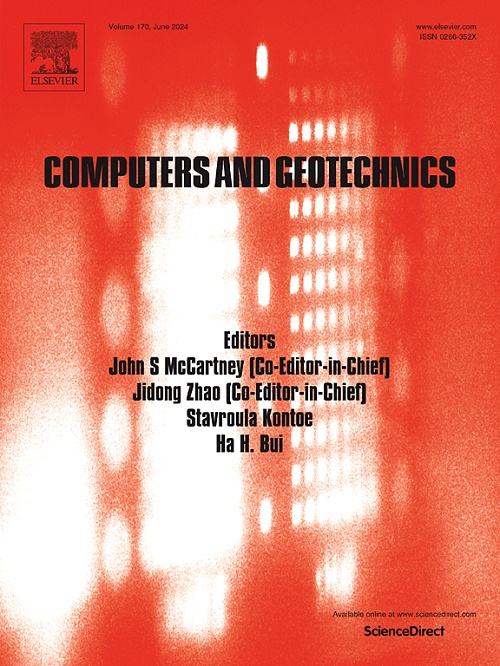Relationship between internal void ratio and morphological parameters of carbonate sand
IF 5.3
1区 工程技术
Q1 COMPUTER SCIENCE, INTERDISCIPLINARY APPLICATIONS
引用次数: 0
Abstract
With the advancement of marine geotechnical engineering, increasing attention has been focused on the influence of the particle morphology and internal voids of carbonate sand (CS) on its engineering properties. The purpose of this study was to explore the relationship between the internal void ratio and particle morphological parameters using X-ray computed tomography (CT) scanning and three-dimensional (3D) reconstruction of CS particles with a particle size of 0.5–1 mm. A unique particle-tray mould was designed using 3D printing to avoid over segmentation of images of the watershed segmentation algorithm during 3D reconstruction and to guarantee scanning accuracy. The mould was made of an acrylonitrile butadiene styrene (ABS) resin with a density that differed significantly from that of the CS, which also facilitated threshold segmentation in 3D reconstruction. In addition, an ambient occlusion algorithm was adopted to compute the surface-connected voids and surface recesses of the CS. Based on the internal void characteristics, CS particles were classified into three types: solid, distributed, and spiral. A random selection of 100 particles from each type was analysed to determine the internal void ratio and morphological parameters. The results indicated that spiral-type CS particles exhibited the highest internal void ratio, followed by distributed-type CS particles, whereas solid-type CS particles had the lowest internal void ratio. Distributed-type CS particles appeared in plate-like or flattened forms, spiral-type CS particles were elongated, and solid-type CS particles displayed significant variability in their shape distribution. Furthermore, no significant correlation was observed between the internal void ratio and particle morphological parameters such as elongation, flatness, or aspect ratio. However, a strong correlation was observed between the internal void ratio and sphericity, convexity, and 3D shape angularity group indicator (SAGI). Both the sphericity and convexity decreased with increasing internal void ratio, whereas 3D-SAGI increased as the internal void ratio increased. Notably, the internal void ratio, sphericity, convexity, and 3D-SAGI of distributed-type CS particles were significantly influenced by the extent of particle surface smoothing, whereas solid- and spiral-type CS particles were not significantly affected. This study can provide the ranges of CS particle morphology parameters for discrete element method modelling and offer convenience for the calibration of void ratios in the future.
碳酸盐砂内部孔隙率与形态参数的关系
随着海洋岩土工程的发展,碳酸盐砂的颗粒形态和内部孔隙对其工程性能的影响越来越受到人们的关注。本研究的目的是通过x射线计算机断层扫描(CT)和三维(3D)重建粒径为0.5-1 mm的CS颗粒,探讨内部空隙率与颗粒形态参数的关系。为了避免分水岭分割算法在三维重建过程中对图像的过度分割,保证扫描精度,采用3D打印技术设计了一种独特的颗粒盘模具。该模具由丙烯腈-丁二烯-苯乙烯(ABS)树脂制成,其密度与CS有很大不同,这也有助于三维重建中的阈值分割。此外,采用环境遮挡算法计算CS的表面连通空隙和表面凹槽。根据CS颗粒的内部孔隙特征,将CS颗粒分为固体、分布和螺旋三种类型。从每种类型中随机选择100个颗粒进行分析,以确定内部空隙率和形态参数。结果表明,螺旋型CS颗粒的内部空隙率最高,其次是分布型CS颗粒,而固体型CS颗粒的内部空隙率最低。分布型CS颗粒呈板状或扁平状,螺旋型CS颗粒呈细长状,固体型CS颗粒在形状分布上表现出明显的变异性。此外,内部空隙率与颗粒形态参数(如伸长率、平整度或纵横比)之间没有显著的相关性。然而,观察到内部空隙率与球度、凸度和三维形状角度组指标(SAGI)之间存在很强的相关性。球体度和凹凸度随内孔隙比的增大而减小,3D-SAGI随内孔隙比的增大而增大。值得注意的是,分布型CS颗粒的内部空隙率、球度、凹凸度和3D-SAGI受到颗粒表面光滑程度的显著影响,而固体型和螺旋型CS颗粒则不受显著影响。该研究为离散元法建模提供了CS颗粒形态参数的范围,为今后孔隙率的标定提供了方便。
本文章由计算机程序翻译,如有差异,请以英文原文为准。
求助全文
约1分钟内获得全文
求助全文
来源期刊

Computers and Geotechnics
地学-地球科学综合
CiteScore
9.10
自引率
15.10%
发文量
438
审稿时长
45 days
期刊介绍:
The use of computers is firmly established in geotechnical engineering and continues to grow rapidly in both engineering practice and academe. The development of advanced numerical techniques and constitutive modeling, in conjunction with rapid developments in computer hardware, enables problems to be tackled that were unthinkable even a few years ago. Computers and Geotechnics provides an up-to-date reference for engineers and researchers engaged in computer aided analysis and research in geotechnical engineering. The journal is intended for an expeditious dissemination of advanced computer applications across a broad range of geotechnical topics. Contributions on advances in numerical algorithms, computer implementation of new constitutive models and probabilistic methods are especially encouraged.
 求助内容:
求助内容: 应助结果提醒方式:
应助结果提醒方式:


